Alaska Fish & Wildlife News
April 2015
Grizzly Bear Denning
in the North Slope Oilfield Region
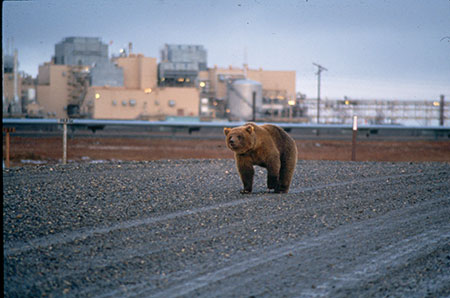
In the early 1990s when ADFG wildlife biologist Dick Shideler began research on grizzly bears living in the North Slope oilfield region, he wondered where the bears denned. Looking around at the relatively flat terrain, with a scattering of features rising only a few meters above mostly wet Arctic tundra, it was easy to believe the “conventional wisdom” that grizzly bears only inhabited this area in the summer and moved back to the foothills and mountains of the Brooks Range to den. Some knowledgeable biologists even speculated that lack of suitable denning habitat limited the number of bears that could live out on the coast. For someone whose concept of denning habitat was framed by grizzly bears denning in alpine areas like the Rocky Mountains or Alaska Range, or bears “nesting” in the big tree country of Southeast Alaska (see the March 2015 issue of AFWN), Shideler considered the pickings for den sites on the Beaufort Sea coastal plain pretty slim.
But now, some 20 plus years later, after inspecting more than 300 dens of 78 radio-collared bears, he has a strong appreciation for the adaptability of grizzly bears to all sorts of habitats. Along the way he has acquired some insights into the features they pick for denning. These insights are important because grizzly bears in his study area share the region with the largest oil and gas development area in North America. Most off-road activities, such as ice road and drill pad construction and seismic exploration, take place in winter when snow cover and frozen ground limit the damage that heavy equipment can do to the tundra. To avoid disrupting grizzly and polar bear denning, land management agencies prohibit industrial work around active dens. Understanding the denning behavior of bears, including where and when they den, is important in fine-tuning this mitigation.
Dates of denning and emergence vary from year to year depending on weather. Pregnant females den up earlier than males, and that’s true of bears in general. Shideler said September 21 is the earliest he’s seen for a pregnant female. By mid-October all the females are in dens where they may remain up to eight months. About 80 percent of the males have denned up by November first. “Males spend less time in the den, and they come out earlier,” he said. “Females also tend to hang around the den longer once they pop out. They stay around for a few weeks with the cubs, using the den as a refuge. They may still be around the den by the first of June.”
The Arctic Landscape
To fully appreciate how grizzly bears have adapted their denning to this ecosystem, it’s important to understand a bit about the processes that govern it and how they influence denning habitat. Foremost is permafrost, the permanently frozen ground that dominates the landscape and extends from hundreds of meters deep to within a meter of the surface in most of the area. As long as its thick insulating cover of short tundra vegetation remains undisturbed, permafrost forms an impermeable barrier that traps rain and melting snow at the surface, creating the extensive wetland landscape. Underneath this inhospitable landscape, however, are more forgiving soils. Because this coastal region was not glaciated, much of the surface soils are mixtures of sand and silt deposited by ancient oceans and large rivers that carried fine sediment from the melting glaciers of the Brooks Range. Large areas of underlying sand dunes were created by ancient winds that blew the sediments around, especially near the deltas of the large rivers.
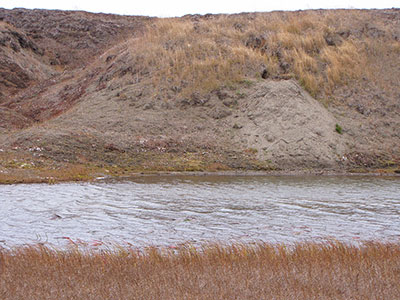
Looking down on the landscape from the air, it would appear that the “conventional wisdom” was right. More than 80 percent of the area is flooded or moist tundra unsuitable for denning. But from the perspective of a bear, the terrain has lots of small-scale elevated areas where the permafrost has melted enough to allow the soil to dry several meters deep. Bears can easily excavate their dens in these sandy soils. Stream and river banks, sand dunes, and certain terrain breaks on low rolling hills all provide den habitat, along with such features as drained lakes and pingos that are unique to permafrost environments.
Drained lakes are pretty much what they sound like: the permafrost in the bank surrounding the lake suddenly melts and, like pulling the plug in a bathtub, the basin drains. This leaves a partially thawed bank a few meters high that eventually dries out allowing bears to dig into it. These areas of potential denning habitat are actually quite plentiful but are scattered around the country sometimes in very small but still useable bits.
“They are using places we never would have expected, which makes it exceptionally hard to map denning habitat,” he said. “We’re looking at some features that are the size of my office.”
The pingo, another permafrost-generated landform, is especially interesting. This ice-cored, conical-shaped mound rises from a few to tens of meters above surrounding wetlands. Although eye-catching, pingos are not plentiful but bears, foxes, Arctic ground squirrels, and wolves all den in them and ancient and modern hunters used them as vantage points for spotting game.
Botanists and biologists recognize the importance of pingos. “They sometimes have different vegetation characteristics than the surroundings,” Shideler said. “Archeologists want to preserve them, they have evidence of human use going back hundreds and even thousands of years. We want to save them for denning.”Shideler said that suitable locations get repeated use, and when they began the study they found a number of den sites in pingos and in terraces. “There are clusters,” he said. “But the dens erode and they’re not really available for the bears to use again. They collapse, basically the spot caves in and you are left with the outline of the den.”
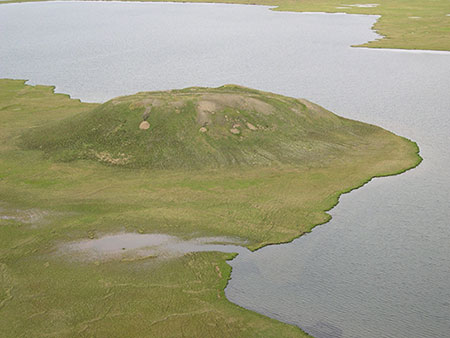
Shideler described most dens as, “The classic picture of a bear den, a short tunnel and a larger nest chamber. The entrances are actually pretty small, you’d think some of the bigger bears would have a hard time getting in. Although there was one in a sandy terrace up from a stream bank that was big enough we could sit up in it. They do substantial digging, I think it’s easy digging for them.”
He knows of one animal that excavated a den in a matter of hours. “I followed one bear in the oil field; he left one night and when I caught up with him the next day he’d already dug his den and was bedded down.”
Location, location, location
The next question that Shideler and his colleagues addressed was why do bears prefer certain places as den sites—for example, why did bears select one short stretch of stream bank or spot on a drained lake bank over another? To get at that answer means considering two processes that strongly affect the Arctic coastal plain: snow and wind. Interestingly enough, this area would be defined as a desert if total precipitation was the measure. Most precipitation falls as snow, but the average annual snowfall is less than half a meter. If this thin snow cover blanketed the ground smoothly, it would not provide much insulation from the severe winter temperatures, but fortunately strong winter winds move the snow around and deposit it in deep drifts that provide good insulation for a denning bear. These drifted areas correspond to the places where bears dig their dens. Drifts that form in early winter are especially important because they seal the open entrance to the den with a plug of snow that keeps the den temperatures well above those on the surface. As these drifts accumulate over winter they provide even more insulation, reducing the loss of stored fat the bears underneath are using to maintain their body temperature. By mid-winter some dens are covered by several meters of dense insulating snow. By late winter some den sites on small streams appear as flat ground because the entire drainage is filled with drifted snow. Someone driving a snowmobile or heavy equipment over that location would be hard pressed to know that there was a den below, or indeed that it was even a stream. But not all areas drift at the right time and place. Shideler has found that a significant proportion of bears select places where the slope faces in roughly a south-southwest direction-- downwind from the prevailing north-northeast winds -- where you would expect the largest drifts to form. Furthermore, much of the winter snowpack develops in fall and early winter, so locations where drifts collect early in the season due to the topography provide longer and better protection. In locations a bit farther inland, low-growing shrubs help catch and hold wind-driven snow, adding to the accumulation in the drift.
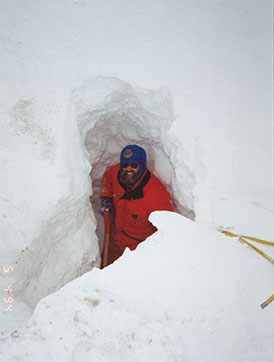
Shideler says researchers can’t say with any scientific certainty whether bears purposefully select these locations or if they just randomly dig wherever they happen to be when the mood to hibernate strikes them. “They’ll dig test dens, scratch around and try different places,” he said. “They do a lot of digging in the fall anyway because they’re eating ground squirrels and roots.” However, pingos provide a pretty good and very suggestive example that bears are selecting locations where drifts will form. On pingos, bears can pick slopes facing all 360° directions. Yet bears denning in pingos select the slope facing generally south-southwest, similar to the dens in other terrain features.
Aspect—the term scientists use for the direction the slope faces—appears to be an important determinant in where bears pick their den sites, and there may be other factors as well. For example, over 60% of the dens were located in or adjacent to Arctic ground squirrel colony burrows. While it is tempting to speculate that bears like a mid-winter snack, Shideler has found no evidence that the bears eat the squirrels while denning. Their proximity may simply be a correlation between the denning needs of bears and the burrow needs of ground squirrels. It’s also possible that bears recognize that the location has the kind of well-drained soil they need by the unique vegetation that surrounds a ground squirrel’s burrow.
Individual experience also appears to affect site selection. Several bears—mostly relatives—have denned for many years in pingos. For example, two sisters have denned for more than 10 years exclusively in pingos. They change pingos every year, occasionally returning to a previously used one. Most of their offspring have also used pingos. Other bears seem to prefer dunes, and still others seem to have no preference all. This variability is an interesting feature of den site selection but certainly makes predicting where the bears will den very difficult.
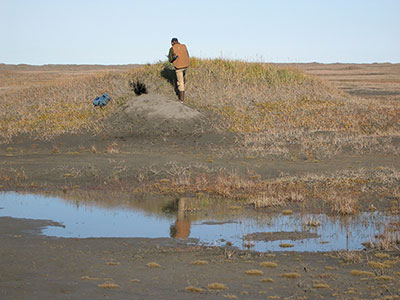
While site preferences vary, most bears do make a bed in the den. “About three-quarters bring in bedding material, and that’s an interesting thing in itself,” Shideler said. “There is a short, low growing heather, cassiope, bell heather, and they’ll go out of their way to drag that in, even when there’s grass that’s closer. I don’t know why they do this, there’s something about it that’s very comfortable. I’ve looked at homeopathic textbooks, older textbooks about Natives using different plants, and I can’t find anything about it.”
“In other places, like dunes where that (heather) doesn’t grow, they’ll bring in grass, wild rye. Sometimes they’ll bring in willows, chew them up and put grass on top of that. One adult, we had to laugh about it, he brought in a bunch of willow sticks about an inch in diameter, and I thought that had to be less comfortable than just lying on bare ground.”
Mapping dens
While identified dens have been mapped and prime locations like pingos are known, ideally biologists would be able to identify and map good denning habitat. The project will wrap up this year, Shideler has about 30 bears radiocollared now and he expects to collect those collars this summer.
The goal now is to develop a method of predictably identifying denning habitat so that industry will be able to avoid such areas, even without the aid of radio collars. Every year at least a handful of dens have been located within seismic projects or near ice roads or pads. This winter, of the 25 known den locations, seven were located within proposed seismic programs. To date, the dens have been located by research staff radio-tracking in the early winter and apprizing industry of the dens within their area of interest. One of the recent objectives of Shideler and his colleagues has been to develop a map of likely denning habitat in the oilfield region so that industry can then focus den detection techniques such as Forward Looking infrared (FLIR) or trained Wildlife Service Dogs to locate dens near proposed winter projects. In the oilfield region, this objective has been frustrated by the lack of fine-scale digital mapping that captures the terrain features where bears den. However, new and more advanced mapping techniques should improve industry’s ability to detect where bears are denning and thus leave them to hibernate undisturbed.
Dick Shideler is a state wildlife biologist based in Fairbanks.
Subscribe to be notified about new issues
Receive a monthly notice about new issues and articles.
